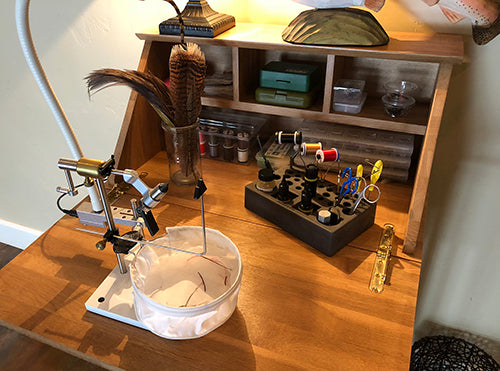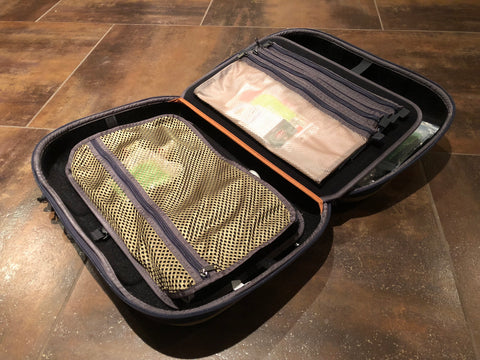5 Tips for Organizing Your Fly Tying Space

Fly tying can be a fun and rewarding hobby especially in the winter. Whether you’re new to fly tying or have been tying for some time, it can be incredibly helpful to organize your fly tying space. Having your area in order, allows you to quickly find your material, promotes consistent fly tying habits along with consistent fly creation, and avoids you having to purchase unneeded material.
Space

First and foremost, find a dedicated fly tying area for yourself including a sturdy desk or table. This will allow you to maximize your time spent at the vise versus laying out material, setting up tools, and having to put everything away at the end of your tying time. What’s more, your fly tying area should be thought of as a peaceful and enjoyable space. It’s the same idea as not having your office in your bedroom. If you’re constrained on space and have limited options, try a mobile fly tying station that organizes your fly tying supplies and simplifies setup and transport.
Separation
Keep your materials and tools separated. Instead of spending time digging through scissors, bobbins, beads, feathers, threads, and hooks, focus tying your flies. In addition, try splitting your materials by size, color, use, etc. so that you can quickly find and assess your inventory. It can also be helpful to keep completed flies split apart so they can quickly be loaded into your fly box when the times comes. Avoid the frustration of having to rummage through bags and boxes of stuff. Remember, fly tying is supposed to be fun and relaxing!

Storage
Once your materials and tools are separated, identify homes for them. Similar to you finding a dedicated space for your fly tying, materials and tools need space too. Material and tool storage doesn’t have to be costly, and you can get quite imaginative when it comes to solutions.
- Materials can be stored in anything ranging from simple bags to multi-drawer organizers to plastic bins and boxes to pencil boxes to good old inexpensive shoe boxe s. One of our favorite inexpensive additions was adding a magnetic pad to the base of the vise to hold hooks for easy grabbing.




- Tools should ideally be kept in a tool caddy either purchased or homemade. All too often tools get dropped or lost and have to be replaced. Similar to your vise, you have made an investment in your tools, and it’s important tokeep them nice as long as possible. We have owned the same scissors for over a decade by simply taking good care of them.

- Flies can also be split and stored in inexpensive plastic, compartment boxes as you complete them in effort to organize and protect them until they make their way to the fly box.
- If you find yourself traveling with your vise, trying using a fly tying kit case. Most cases include storage for your vise, tools, and materials .

Specify
 Label your fly tying supplies as you assign homes for them. This can be as simple as using a marker and tape or as sophisticated as using a hand-held labeling machine. What’s most important is to identify the location of your materials including sizes, colors, etc.
Label your fly tying supplies as you assign homes for them. This can be as simple as using a marker and tape or as sophisticated as using a hand-held labeling machine. What’s most important is to identify the location of your materials including sizes, colors, etc.
Scraps
Lastly and most important, keep it clean and remove unwanted material. Whether it be scraps from a fly you just tied or material you no longer need, get rid of it! For the vise, you can simply place a container under your vise or purchase a waste catcher.

It’s also helpful to go through your material periodically and throw away anything you no longer need. Try to take the time at least once a month to pick up and dust your area in effort to keep it clean. In addition, making the investment and keeping a trash basket near your fly tying station is a must.
Fly tying is a wonderful opportunity to bring your fly fishing experience full circle and a great past time. By keeping it organized, you’ll find yourself enjoying fly tying more than ever not to mention you’ll impress those who see your space.
Helpful Fly Tying Organization Tools:

